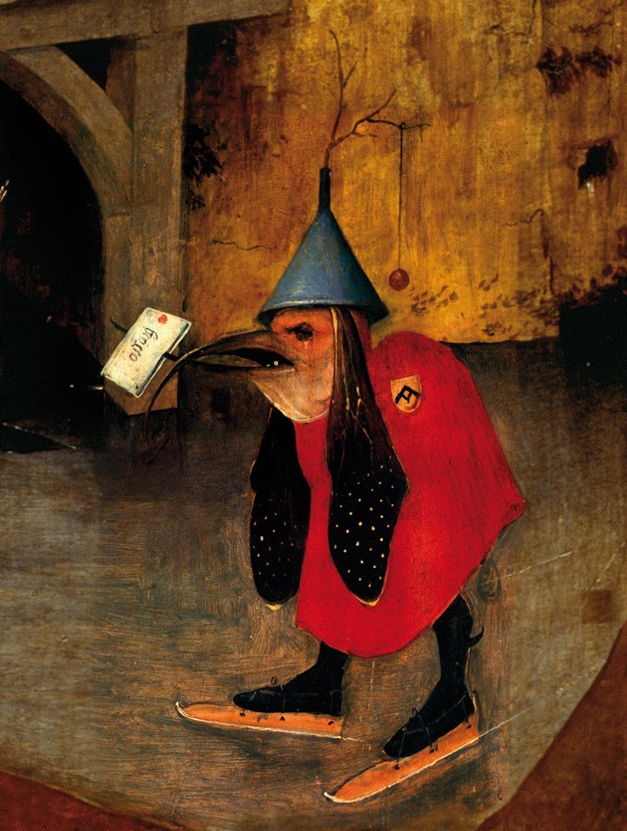Hieronymus Bosch’s works are among the most visually intense paintings, packed with hordes of his distinctive visual inventions. They may at first seem overwhelming, but as you get to know his paintings better, patterns and order start to emerge.
One of his most visually consistent elements is, of course, his signature owl. There are many other characters and creatures which appear variously in several paintings: the man riding with a sword impaling him, creatures with spoon bills, and more. This, the last of my scheduled articles in honour of the five-hundredth anniversary of Bosch’s death, looks at one of his more curious and opaque visual devices, the inverted funnel worn as headgear, something which I have not seen analysed elsewhere.
(Note that some of the images shown here are quite small details and will not enlarge in the normal way, as they are already at maximum resolution. I apologise for this.)
Coming from an artistic family, Bosch must have had access to an extensive library of images, and many of his works show influence from contemporary prints. I suspect that he was well aware, possibly even from first-hand experience, of the traditional hats worn by Jews at the time.
Their origin goes back to the Jewish diaspora of the Middle Ages, when Ashkenazi Jews (in particular) migrated to northern Europe, from about 800 CE. Predominantly Christian powers sought to make visible signs to distinguish Jews (and, to a lesser extent, Muslims) from local Christians, and for many centuries the migrants were persecuted, confined to Jewish ghettos, and generally kept in isolation as much as possible.
One common discriminatory technique employed in much of northern Europe was to require Jews to wear distictive hats. This played on religious requirements for Jews to cover their heads, and the fact that most people wore hats when they were outdoors. The patterns of Jewish hat most often recorded are pointed or conical, and some have highly distinctive ‘bobbles’ at the top.

Although it is often stated that these Jewish hats appeared after 1215, graphical records of them start in the 1100s, here in a miniature from the Codex Bodmer from 1170-1200.

By the 1300s these were well-known, and some miniatures showing them, here a painting by Rudolf von Ems in the Weltchronik of 1350-1375, show how similar they had become to inverted funnels (which were in general use by this time).

The Master of the Třeboň Altarpiece shows a couple of examples in the Bearing of the Cross (c 1390).

They are also to be seen in more recent historically-accurate depictions of the Middle Ages, as shown by Carl Gustaf Hellqvist in the right of his wonderful large history painting of Valdemar Atterdag holding Visby to ransom, 1361 (1882).


Some of Hieronymus Bosch’s earlier paintings show variations on this theme, including an unusual armoured version seen in the crowd in his Ecce Homo.

It was not until his Last Judgment (Bruges, c 1495-1505), though, that Bosch makes the visual transformation from the Jewish hat to an inverted funnel, as seen in the right wing of that triptych.

This peaks in his Temptation of Saint Anthony (Lisbon, c 1500-10): here the crossbill bearing a letter, in the foreground of the left wing, is wearing a funnel on its head.

In the centre panel, a rotund creature at the foot of the decorated pillar is wearing another.

The same theme appears in the Nelson-Atkins fragment of The Temptation of Saint Anthony (c 1500–10), where the funnel has now consumed the entire body, leaving just the arms and legs sticking out.

One of the gluttons shown in the Gluttony and Lust fragment of the left wing of The Wayfarer triptych (1500-10) is both rotund and wearing an inverted funnel on his head.

This particular visual invention had faded away by the time of Bosch’s The Haywain Triptych (c 1510-16), although its central panel still contains some headgear probably derived from the appearance of the Jewish hat.
The inverted funnel did not die with Bosch in 1516. Such was the popularity and influence of his paintings (and copies) of The Temptation of Saint Anthony that others propagated their visual elements.

Cornelis Massijs tucked a tiny creature away in his version of about 1540, but there is no doubt that it is wearing a shiny inverted funnel.

Maerten de Vos seems to have been the first to develop Bosch’s inverted funnel to hold a lit candle in its spout, in 1591-4.
David Teniers the Younger painted at least three different versions, each using de Vos’s variant, around 1650-60, over a century after Bosch’s death.



At about the same time, Joos van Craesbeeck brought together several themes from Bosch’s images in his Temptation of Saint Anthony: the inverted funnel hat, a rider facing the wrong way (although not impaled by a sword), playing the lute, a duck, and a unicorn.

Although wearing an inverted funnel as a hat seems to have died out in later paintings, this visual device has evolved further, developing from the fear of Jews which so often bubbled up in European society. The funnel reverted to a cone, and became the standard tall conical hat which is characteristic of magicians, wizards, and those who meddle with the occult.
So next time that you encounter a wizard’s hat, remember Bosch’s funnels, and their role in shaping our visual imagery.
Reference
Falkenburg R (2011) The Land of Unlikeness: Hieronymus Bosch, The Garden of Earthly Delights, WBOOKS. ISBN 978 9 040 07767 8.

